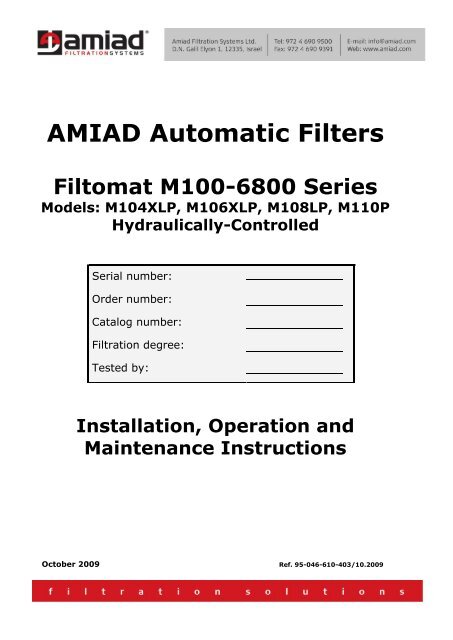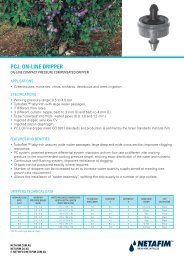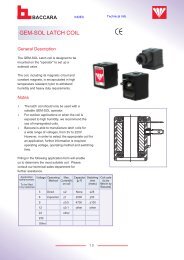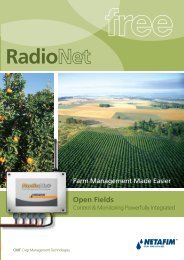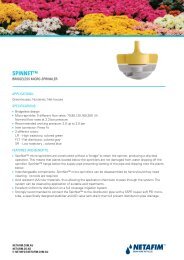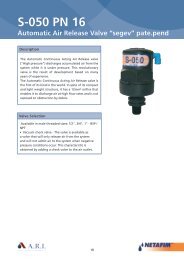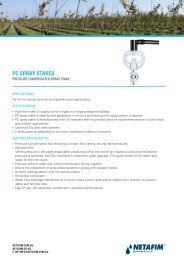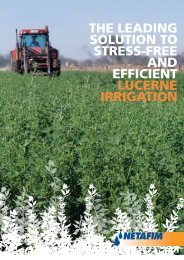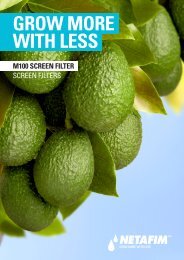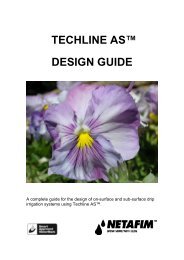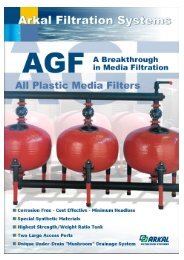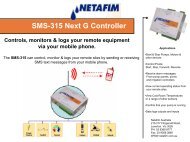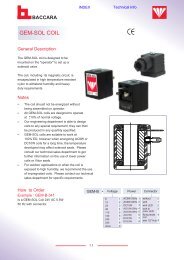AMIAD Automatic Filters Filtomat M100-6800 Series Models - Netafim
AMIAD Automatic Filters Filtomat M100-6800 Series Models - Netafim
AMIAD Automatic Filters Filtomat M100-6800 Series Models - Netafim
Create successful ePaper yourself
Turn your PDF publications into a flip-book with our unique Google optimized e-Paper software.
<strong>AMIAD</strong> <strong>Automatic</strong> <strong>Filters</strong><br />
<strong>Filtomat</strong> <strong>M100</strong>-<strong>6800</strong> <strong>Series</strong><br />
<strong>Models</strong>: M104XLP, M106XLP, M108LP, M110P<br />
Hydraulically-Controlled<br />
Serial number:<br />
Order number:<br />
Catalog number:<br />
Filtration degree:<br />
Tested by:<br />
Installation, Operation and<br />
Maintenance Instructions<br />
October 2009 Ref. 95-046-610-403/10.2009
Amiad <strong>Automatic</strong> <strong>Filters</strong><br />
<strong>M100</strong>-<strong>6800</strong> <strong>Series</strong><br />
<strong>Models</strong>: M104XLP, M106XLP, M108LP, M110P Hydraulically-<br />
Controlled<br />
This document is the user-manual of the <strong>Filtomat</strong> <strong>M100</strong> Hydraulically Controlled <strong>Series</strong> and it<br />
describes the installation, the operation and the maintenance procedures of the filters.<br />
isclaimer:<br />
This document and the information enclosed within it contain restricted and/or privileged information that are intended only for usage by<br />
authorized Amiad technicians. If you are not a qualified Amiad technician you must not take nay action in reliance to this document,<br />
unless permitted by Amiad.<br />
None of the procedures provided on this file may be used in any form or by any means without permission from Amiad.<br />
If you received this file in error please notify Amiad immediately. (reuven@amiad.com)<br />
The confidential nature of and/or privilege in the file enclosed is not waived or lost as a result of a mistake or error in this file.<br />
Amiad accepts no liability whatsoever, whether it was caused by:<br />
1. Accessing or other related actions to this file.<br />
2. Any links, procedures or materials provided/attached to this file.<br />
Amiad assumes that all users understand risks involved within this file and/or its attached materials.<br />
All the procedures, drawings, pictures and/or any other information provided in this document are presented as general information only;<br />
they can be altered, removed or changed without any further notice by Amiad.<br />
This document does not replace any certified drawing, procedure or information provided by Amiad in reference to a specific customer,<br />
site or project.<br />
All rights reserved.<br />
Ref. 95-046-610-403/10.2009<br />
<strong>Filtomat</strong> <strong>M100</strong>-<strong>6800</strong> 10.2009 Page 2 of 24
TABLE OF CONTENTS<br />
Specifications ……………………………………………………………………………………………………………… 4<br />
Safety instructions ……………………………………………………………………………………………………. 5<br />
Dimensional drawing ………………………………………………..………………………………………………. 6<br />
Introduction ……………………………………………………………………………………………………………….. 7<br />
Installation ………………………………………………………………………………………………………………….. 9<br />
Preparations for installation ………………………………………………………………………………………. 10<br />
Troubleshooting …………………………………………………………………………………………………………. 11<br />
Adjusting the rinse controller ……………………………………………………………………………………. 11<br />
Maintenance …………………………………………………………………………………………………………….... 12<br />
Servicing …………………………………………………………………………………………………………………….. 13<br />
Parts schedule ……………………………………………………………………………………………………………. 19<br />
Parts drawing #1 ……………………………………………………………………………………………………….. 20<br />
Parts drawing #2 ……………………………………………………………………………………………………….. 21<br />
Parts drawing #3 ……………………………………………………………………………………………………….. 22<br />
Parts drawing #4 ……………………………………………………………………………………………………….. 23<br />
Control drawing ………………………………………………………………………………………………………….. 24<br />
With any inquiry please quote the Filter Serial Number, located on the filter housing.<br />
<strong>Filtomat</strong> <strong>M100</strong>-<strong>6800</strong> 10.2009 Page 3 of 24
SPECIFICATIONS<br />
General<br />
Maximum flow rate 400m 3 /h; 1760USgpm Consult manufacturer for optimum flow<br />
depending on filtration degree & water<br />
quality.<br />
Min. working pressure 2.5bar; 38psi<br />
Max. working pressure 10bar; 150psi<br />
Filter area Flat screen 4600cm 2 ; 713in 2<br />
Molded screen 6300cm 2 ; 976in 2<br />
Inlet/Outlet diameter 100,150,200, 250mm;<br />
4", 6", 8", 10"<br />
Max. working temperature 60 0 C; 140 0 F<br />
Empty / Full weight – M104XLP 121kg / 225kg; 270lb / 500lb<br />
Empty / Full weight – M106XLP 131kg / 241kg; 290lb / 535lb<br />
Empty / Full weight – M108LP 151kg / 330kg; 335lb / 735lb<br />
Empty / Full weight – M110P 170kg / 362kg; 375lb / 805lb<br />
Flush data<br />
Exhaust valve 40 mm; 11/2"<br />
Flange standards as per request.<br />
Flushing cycle time 15 seconds Depending on the working pressure<br />
Wasted water per cycle 125liter; 35USgallon at 2bar; 30psi<br />
Minimum flow for flushing 30m 3 /h; 130USgpm at 2bar; 30psi<br />
Flush criteria Differential pressure of 0.5 bar; 7psi and manual operation<br />
Construction materials<br />
Filter housing Epoxy-coated carbon steel 37-2 (St. St. 316 available on request)<br />
Filter lid Epoxy-coated carbon steel 37-2 (St. St. 316 available on request)<br />
Coarse screen Reinforced nylon<br />
Fine screen Stainless Steel 316, molded plastic support structure<br />
Cleaning mechanism PVC and Stainless Steel 316L<br />
Motor assembly Reinforced nylon, brass, stainless steel<br />
Hydraulic piston Stainless Steel 316, brass<br />
Control tubing Polyethylene<br />
Seals BUNA-N<br />
Control Aluminum, Brass, Stainless Steel 316, PVC, Acetal<br />
Filtration degrees available<br />
Type Molded screen Flat screen<br />
micron 500 300 200 130 100 80 800 400 200 150 130 100 80 50<br />
mm 0.5 0.3 0.2 0.13 0.1 0.08 0.8 0.4 0.2 0.15 0.13 0.1 0.08 0.05<br />
<strong>Filtomat</strong> <strong>M100</strong>-<strong>6800</strong> 10.2009 Page 4 of 24
SAFETY INSTRUCTIONS<br />
General<br />
� Carefully read the installation and operation instructions prior to installation or handling of<br />
the filter.<br />
� While working with the filter all conventional safety instructions should be observed in order<br />
to avoid danger to the workers, the public or to property in the vicinity.<br />
� Note that the filter may begin a flush cycle automatically, without prior warning.<br />
� No changes or modifications to the equipment are permitted without written consent<br />
provided by the manufacturer or by its representative, on the manufacturer's behalf.<br />
Operation, Control and Maintenance<br />
� Loosening or unscrewing bolts should be done only after the pressure in the filter has been<br />
released.<br />
� Avoid splashing and water leakage in order to reduce danger of slipping, electrical danger or<br />
damage to the equipment caused by moisture.<br />
� Always open and close valves gradually.<br />
� Remove grease and fat material residues in order to avoid slipping.<br />
� Manual cleaning of filter element using high water pressure or steam should be performed in<br />
accordance with the cleaning system instructions and without endangering the operator or<br />
his working area.<br />
� Manual cleaning of filter element using acid or other chemical agents should be performed in<br />
accordance with the relevant material safety instructions and without endangering the<br />
operator or his working area.<br />
Use of Lifting Equipment<br />
� While using lifting equipment, make sure that the filter or the lifted part is chained securely<br />
and in a safe manner.<br />
� Avoid working below lifted equipment.<br />
� Wear a safety helmet while using lifting equipment.<br />
<strong>Filtomat</strong> <strong>M100</strong>-<strong>6800</strong> 10.2009 Page 5 of 24
DIMENSIONAL DRAWING<br />
M106XLP<br />
<strong>Filtomat</strong> <strong>M100</strong>-<strong>6800</strong> 10.2009 Page 6 of 24
INTRODUCTION<br />
The FILTOMAT <strong>M100</strong>-<strong>6800</strong> <strong>Series</strong> are sophisticated, yet easy-to-operate automatic filters,<br />
with a self-cleaning mechanism driven by a hydraulic turbine. The FILTOMAT <strong>M100</strong>-<strong>6800</strong><br />
<strong>Series</strong> is designed to work with various types of screens in filtration degrees from 800 to 50<br />
micron, and is available in 4", 6", 8" and 10" inlet/outlet diameter.<br />
The FILTOMAT <strong>M100</strong>-<strong>6800</strong> <strong>Series</strong> filters are configured to meet your specific needs according<br />
to flow rates and water quality. These filters can be installed as stand-alone units for low flow<br />
rates, or assembled in a group on a manifold when high flow rates and/or a large screen area<br />
are required. The filters are delivered fully assembled, requiring a simple connection to the inlet<br />
and outlet and to the drain.<br />
General Description<br />
Water enters the filter through the inlet pipe and passes through a coarse screen which is<br />
designed to protect the cleaning mechanism from large dirt particles. It should not accumulate<br />
large quantities of suspended solids and is not cleaned automatically. The water then flows<br />
through a fine screen that filters out the smaller particles. Clean water then flows from the filter<br />
through the outlet. The particles form a "filtration cake" which accumulates on the fine screen<br />
surface. The cake build-up increases the pressure differential across the fine screen, and at a<br />
pre-set value (0.5bar; 7psi) the automatic self-cleaning cycle begins. Clean water continues to<br />
flow through the outlet. The clean water flow is maintained during this backflush cycle. Suction<br />
nozzles sweep across the surface of the fine screen pulling debris off and exhausting it out of<br />
the drain port.<br />
This innovative self-cleaning process, utilizes the backflush technique and dirt collector to<br />
effectively remove the dirt particles from the fine screen, and provide an uninterrupted<br />
downstream flow during the cycle.<br />
The <strong>M100</strong>-<strong>6800</strong> <strong>Series</strong> filters are hydraulically operated units. No external power source is<br />
required. This type of control enables operation at remote installation sites. Alternatively, where<br />
electricity is available, an electronic controller can also be incorporated into the filter.<br />
<strong>Filtomat</strong> <strong>M100</strong>-<strong>6800</strong> 10.2009 Page 7 of 24
Self-Cleaning Cycle<br />
The automatic flushing cycle described below takes a few seconds and does not interrupt the<br />
supply of process water.<br />
Water flows from the inlet through the coarse and fine screens to the outlet. At a pre-set<br />
pressure differential (0.5 bar —7 psi), the rinse controller activates the piston and opens the<br />
flushing valve. The water from the rotor chamber flows out the drain. The pressure in the rotor<br />
chamber drops, releasing a strong flushing stream that flows through the filter.<br />
This drop in pressure and corresponding release of the backflush stream create suction at the<br />
nozzle tips. This effect actuates spot cleaning directly in front of the openings of each nozzle on<br />
the inner surface of the fine screen. The water and particles passing through the hydraulic rotor<br />
cause the dirt collector to rotate, and the piston moves in an axial direction to the opposite end<br />
of the filter.<br />
The combination of rotational and axial movement of the dirt collector assembly ensures that<br />
the nozzles sweep the entire inner surface of the fine screen.<br />
When the first stroke is completed, the flushing valve closes and after a very short interval the<br />
rinse controller activates the second backflush stroke. The dirt collector assembly spins, moving<br />
with the piston in the opposite direction and returning to its original position.<br />
This self-cleaning process takes between 8–15 seconds, depending on the operating pressure.<br />
<strong>Filtomat</strong> <strong>M100</strong>-<strong>6800</strong> 10.2009 Page 8 of 24
INSTALLATION<br />
Read these instructions carefully before installing and operating the filter.<br />
Design Recommendations<br />
� If a prolonged pipeline fill time causes a temporary high flow and low pressure situation, it is<br />
recommended that you install a pressure sustaining valve downstream of the filter. The<br />
pressure-sustaining valve will ensure a controlled fill-up of the line.<br />
� The upstream pressure source should not drop below 38 psi (2.5 bar) during the rinse cycle.<br />
If this cannot be ensured, consult the manufacturer.<br />
� If continued water delivery is essential even during ―down time‖ maintenance periods, it is<br />
recommended that a manual or automatic by-pass be installed, and that isolating valves be<br />
installed up and downstream of each filter unit for isolation purposes.<br />
� Avoid placing the drainage pipe on a rising slope to minimize backpressure.<br />
� Secure the open end of the drain pipe to prevent movement during the rinse cycle.<br />
� It is recommended to install a mechanical non-return valve downstream of the filter to<br />
prevent backflow damage to the screen.<br />
� It is recommended to install a pressure gauge on the three-way valve.<br />
� Check that there is sufficient space to remove the cover assembly and the screen from the<br />
filter for troubleshooting.<br />
Preparations for Installation<br />
� Ensure suitable lighting at the area of the filter to enable good visibility and safe<br />
maintenance.<br />
� Arrange suitable platforms and safety barriers to enable easy, safe access to the filter.<br />
� Allow a convenient approach and enough space for dismantling and maintenance.<br />
Installation Procedure<br />
Ensure the direction of flow is according to the arrows marked on the filter housing.<br />
1. Connect a minimum of 3" (75 mm) pipe to the exhaust valve. The exhaust pipe should be<br />
designed so that it creates minimal resistance to flow of 20 m3/h (88 US-gpm). Water<br />
should be allowed to flow to atmosphere freely from the exhaust pipe.<br />
2. Connect a minimum of 1" (25 mm) flexible tube to the rinse controller drain port. Ensure<br />
this drain line is open to atmosphere.<br />
IMPORTANT!!<br />
� Prevent static back pressure or reverse flow through the filter.<br />
� Install a manual or a hydraulic valve downstream of the filter.<br />
NOTE: The filter may enter flushing mode automatically, without prior warning.<br />
<strong>Filtomat</strong> <strong>M100</strong>-<strong>6800</strong> 10.2009 Page 9 of 24
PREPARATIONS<br />
Before using the filter for the first time, go through the following check-list carefully. No special<br />
training is required to carry out these activities.<br />
� Check that the upstream pressure at the filter inlet is more than 2.5 bar (38 psi) during the<br />
rinse cycle.<br />
� Check that the filter is mounted in the correct flow direction.<br />
� Check that all the control tubes are connected properly and that all connections are tight.<br />
� Check that the three-way mini-valve is turned to the automatic position. The arrow on the<br />
knob should point to AUTO, and the sticker � on the filter.<br />
� The nominal diameter of the drainpipe should be at least 3" (75mm).<br />
� If the recommended upstream and downstream isolation valves have been installed, check<br />
that they are shut.<br />
GETTING STARTED<br />
First operation of filter<br />
After completing the preparation check-list above, perform the following steps:<br />
1. Slowly open the isolating valve at the filter inlet. Water will flow into the filter.<br />
2. Check for leaks and repair if necessary.<br />
3. Check that the minimum inlet pressure remains 2.5bar (38psi) or higher.<br />
4. Slowly open the isolating valve at the outlet of the filter.<br />
5. If there is a by-pass valve, close it slowly.<br />
6. Ensure the flow through the filter does not exceed the filter's published maximum flow rate.<br />
7. Start a manual flush by turning the three-way valve to the OPEN position for a few seconds,<br />
and then turn it back to AUTO.<br />
8. During the self-cleaning cycle, check the pressure at the filter inlet and in the rotor chamber.<br />
NOTE: The minimum pressure in the rotor chamber should be 1.5bar (22psi) lower than the<br />
inlet pressure.<br />
<strong>Filtomat</strong> <strong>M100</strong>-<strong>6800</strong> 10.2009 Page 10 of 24
TROUBLESHOOTING<br />
Problem Possible Cause Solution<br />
The filter does not<br />
flush<br />
Excessive pressure in<br />
the rotor chamber<br />
Insufficient inlet<br />
pressure (less than 2<br />
bar—30 psi)<br />
Pressure differential<br />
exceeds 0.7 bar (10<br />
psi) during normal<br />
operation<br />
Water does not flow<br />
through the filter<br />
ADJUSTING THE RINSE<br />
CONTROLLER<br />
Valves are closed Open valves<br />
Pressure differential is not<br />
correct<br />
Perform a manual flush as follows:<br />
1. Close the filter outlet valve<br />
2. Check that the filter outlet and inlet<br />
pressures are equal<br />
3. Perform a manual flush as in item 7,<br />
page 9.<br />
4. Check the pressures at the inlet valve<br />
and in the rotor chamber<br />
Change dripper<br />
Rinse controller dripper<br />
blocked<br />
Rinse controller has been Check and readjust screw on rinse controller<br />
adjusted incorrectly<br />
(see below)<br />
Drain pipes are not clear Check if drain lines are clear. If necessary<br />
replace with a larger (diameter) flush drain<br />
line, or shorten the existing lines.<br />
Inlet valves not fully open Open inlet valves to maximum.<br />
Increase the inlet pressure or throttle the<br />
outlet to increase pressure during the flush<br />
cycle.<br />
Coarse filter is blocked Check coarse filter<br />
Rinse controller needs<br />
Adjust rinse controller (see below)<br />
adjusting<br />
Check for blockage at high pressure sensor<br />
connection.<br />
Inlet lines blocked Check inlet lines<br />
Isolating valves are closed Open isolating valves<br />
NOTE: Improper adjusting of the rinse controller may<br />
cause the filter to malfunction.<br />
1. Disconnect the rinse controller drain line.<br />
2. Loosen the locking nut on the long nose (1) and<br />
loosen (CCW) the adjusting screw (2) until a flush<br />
cycle begins.<br />
3. Turn the adjusting screw (2) clockwise 1.5 times,<br />
and then tighten the locking nut (1). This adjusts<br />
the rinse controller for a differential pressure of 5m<br />
(7psi).<br />
4. Observe at least one automatic self-cleaning cycle,<br />
if possible.<br />
The rinse controller is originally pre-set for a<br />
differential pressure of 0.5bar (7psi).<br />
<strong>Filtomat</strong> <strong>M100</strong>-<strong>6800</strong> 10.2009 Page 11 of 24<br />
2<br />
1
MAINTENANCE<br />
NOTE: Depressurize the filter before maintenance (close inlet, and then outlet valve).<br />
Checking the Filter<br />
1. Remove the filter cover by unscrewing the fastening nuts.<br />
2. Extract the fine screen and clean if necessary. Cleaning may be performed by hosing the<br />
screen from outside-in, and/or with a nylon brush.<br />
3. Check the coarse screen and clean if necessary.<br />
4. Check the O-rings of the fine screen and apply grease, if necessary.<br />
5. Reassemble the fine screen.<br />
NOTE: Check that the dirt collector shaft is properly aligned in the bearing.<br />
6. Return the cover and fasten the nuts.<br />
7. Perform First Operation of Filter as on page 10.<br />
Winterization<br />
Filter operations should be suspended in climates where the filter is exposed to freezing<br />
temperatures.<br />
1. Check that the outlet isolating valve is closed and perform two manual rinses.<br />
2. Close the inlet valve to the filter and release the pressure.<br />
3. Remove all drain lines from the valves and rinse controller. These should be drained of<br />
water and re-connected.<br />
4. Remove the following items from the filter and store in a dry place:<br />
� Top cover assembly<br />
� Coarse and fine screen assembly<br />
� Rinse controller<br />
5. Apply grease to the O-rings of the fine screen before storing.<br />
At the beginning of the operation season, reassemble the filter elements and check<br />
Preparations (on page 10) and First Operation of Filter (page 10).<br />
<strong>Filtomat</strong> <strong>M100</strong>-<strong>6800</strong> 10.2009 Page 12 of 24
SERVICING<br />
Draining the Filter<br />
1. Close the filter’s upstream (inlet) valve.<br />
2. Close the filter’s downstream (outlet) valve and isolate the filter from the water system.<br />
3. Use the manual start function of the electronic flushing controller and start a flushing<br />
cycle to release the pressure of the filter housing.<br />
Removing the Screen and the Dirt Collector<br />
1. Drain the filter as described above.<br />
2. Remove the filter cover nuts and the cover. Note: Attempting to remove the screen<br />
from the piston-side of the filter will cause damage to the system.<br />
3. Pull the coarse screen out of the filter housing.<br />
<strong>Filtomat</strong> <strong>M100</strong>-<strong>6800</strong> 10.2009 Page 13 of 24
4. Pull the fine screen out of the filter housing. If it is difficult to release the screens use<br />
Amiad’s Push Pull Tool (Catalog Number 15-3000-0011) to extract the screen by performing<br />
the following procedure:<br />
A. Assemble the tool by inserting the fork shape part into the lever handle.<br />
B. Insert the fork shape part over the dirt collector shaft.<br />
C. Turn the tool clockwise till the fork teeth catch the fine screen handle.<br />
D. Lay the tip of the tool’s lever handle on one of the filter’s housing cover bolts (in<br />
order not to damage the filter paint coating) and secure the joint pin.<br />
E. Pull the handle firmly to release the screen.<br />
F. Pull the screen out of the filter housing.<br />
A<br />
Joint Pin Lever Handle<br />
Fork Shape<br />
<strong>Filtomat</strong> <strong>M100</strong>-<strong>6800</strong> 10.2009 Page 14 of 24
D<br />
<strong>Filtomat</strong> <strong>M100</strong>-<strong>6800</strong> 10.2009 Page 15 of 24<br />
B<br />
C<br />
E
F<br />
5. Depending on the actual diameter of your filter use two units of Amiad’s Screen<br />
Separation Tool (Catalog Number 65-9999-0203 for 2‖-8‖, 65-9999-0204 for 10‖-12‖ or<br />
65-9999-0205 for 14‖-16‖ filters) to separate the Chamber Flat Screen and the Dirt<br />
Collector from the Fine Screen.<br />
<strong>Filtomat</strong> <strong>M100</strong>-<strong>6800</strong> 10.2009 Page 16 of 24
Re-installing the Screen and the Dirt Collector<br />
1. Insert the Dirt Collector to the Fine Screen. Make sure that the first suction nozzle of the<br />
Dirt Collector (A) is pointing downwards when inserted into the Fine Screen.<br />
2. Use the two Amiad’s Screen Separation Tools to reconnect the Chamber Flat Screen and<br />
the Fine Screen.<br />
3. Insert the fine screen back to the filter housing (A). Use the fork part of the Push Pull<br />
Tool to lift the screen and push it through the last few centimeters till it is correctly<br />
seated in the filter housing (B).<br />
<strong>Filtomat</strong> <strong>M100</strong>-<strong>6800</strong> 10.2009 Page 17 of 24<br />
A<br />
A
4. Insert the Coarse Screen back to the filter housing (A), install the filter’s cover (B) and retighten<br />
the cover bolts nuts (c).<br />
A B C<br />
<strong>Filtomat</strong> <strong>M100</strong>-<strong>6800</strong> 10.2009 Page 18 of 24<br />
B
PARTS SCHEDULE<br />
No. Description Cat. No.<br />
1 Filter housing 104XLP 15-14XX-XXXX<br />
1 Filter housing 106XLP 15-16XX-XXXX<br />
1 Filter housing 108LP 15-18XX-XXXX<br />
1 Filter housing 110P 15-110X-XXXX<br />
1.1 Plastic plug 1" 8398-1001-003-000<br />
1.2 Fitting 3/8" x 12 82-1174-6952-06<br />
1.3 Plastic plug 1/4" 8211-0121-0400<br />
1.4 3-Way valve 84-3170-0011<br />
1.4.1 Nipple 1/4" X 1/8" 83-4324-1012-1925<br />
1.5 Rinse controller 15-1007-0050<br />
1.6 3/4" plastic filter 55-1000-0001<br />
1.7 Bracket 63-6044-0023<br />
1.8 Plastic plug 1/4" 8211-0121-0400<br />
1.9 Stud bolt 1/2" X 50 (X16) 85-2431-08-050<br />
2 Fine screen 104-106XLP 15-1603-XXXX<br />
2 Fine screen 108LP/110P 15-1803-XXXX<br />
2.1 O-Ring 647 81-41-4001-0674<br />
2.2 Handle bolt 104-106 LP/XLP 8521-2101-008<br />
2.2 Handle bolt 108LP/110P 8541-2101-008<br />
2.3 Handle 104-106 LP/XLP 61-5510-0152<br />
2.3 Handle 108LP/110P 61-5510-0154<br />
2.4 Spacer disc 65-3903-0123<br />
2.5 Fine screen bearing 65-3003-0204<br />
3 D. collector assembly 15-1004-1046<br />
3.1 O-Ring 647 81-41-4001-0674<br />
3.2 Rotor assembly 55-1006-0011<br />
3.2.1 Rotor DAG1.00015<br />
3.2.3 Rotor bearing housing 65-1024-0026<br />
3.2.4 Lower Bearing 65-1004-0601<br />
3.3 F. chamber flat screen 15-1070-0506<br />
3.3 F. chamber ZZ screen 15-1070-0508<br />
3.4 Dirt collector 15-1004-0016<br />
3.4.1 Bolt 3/8" X 8 85-4125-08-009<br />
3.4.2 Dirt collector pipe 65-1064-0547<br />
3.4.3 Nozzle assembly DKF1.00269<br />
3.4.4 Collector connecting bolt 65-3044-0451<br />
3.4.5 Support bolt 51-5510-0010<br />
No. Description Cat. No.<br />
3.4.6 Dirt collector shaft 65-3044-0110<br />
3.4.7 Dirt collector top plug 51-5510-0024<br />
4 Piston lid assembly (CI) 15-1070-0591<br />
4.1 Piston lid 55-1070-1093<br />
4.2 Plastic plug 1/4" 82-11-0121-0400<br />
4.3 L-Connector 1/4" X 6 82-11-6469-4604<br />
4.4 Piston shaft 65-1005-0522<br />
4.5 Exhaust valve seat DPF1.00006<br />
4.7 O-Ring P2-009 81-41-4000-0009<br />
4.8 Rod DAF1.00150<br />
4.9 O-Ring P2-009 81-41-4000-0009<br />
4.10 Exhaust valve seat 65-1006-0591<br />
4.11 O-Ring P2-351 81-41-4000-0351<br />
4.12 Locking ring 65-1006-0592<br />
4.13 Disc seal seat DPF1.00005<br />
4.15 St.St. Nut 1/4" 85-2211-04-000<br />
4.16 O-Ring P-237 81-41-4000-0237<br />
4.17 U-Ring 95X75X10 81-41-4561-0530<br />
4.18 Seal holder 65-1006-0539<br />
4.19 U-Ring 95X75X10 81-41-4561-0530<br />
4.20 St.St. Cylinder 65-1006-0527<br />
4.21 Piston rod tie 65-1005-0593<br />
4.22 O-Ring P-237 81-41-4000-0237<br />
4.23 Piston lid 65-5510-0006<br />
4.24 St.St. Lock nut 1/4" 85-2231-04-000<br />
4.25 St.St. Washer M6 85-2312-06-000<br />
4.26 Plastic plug 1/4" 82-11-0121-0400<br />
4.27 Fitting 3/8" x 12 82-1174-6952-06<br />
5 Coarse screen 104XLP/106XLP 15-3002-0003<br />
5 Coarse screen 108LP/110P 15-3002-0001<br />
6 Filter lid 55-1070-1091<br />
7 O-Ring P 2-448 81-41-4000-0448<br />
8 Nut 1/2" (X 16) 85-1211-08-000<br />
9 Washer 1/2" (X 16) 85-1312-12-000<br />
10 Nipple 11/2" NPT 83-2920-0151-0105<br />
10 Nipple 11/2" BSP 83-2920-0150-0105<br />
<strong>Filtomat</strong> <strong>M100</strong>-<strong>6800</strong> 10.2009 Page 19 of 24
PARTS DRAWING #1<br />
<strong>Filtomat</strong> <strong>M100</strong>-<strong>6800</strong> 10.2009 Page 20 of 24
PARTS DRAWING #2<br />
<strong>Filtomat</strong> <strong>M100</strong>-<strong>6800</strong> 10.2009 Page 21 of 24
PARTS DRAWING #3<br />
<strong>Filtomat</strong> <strong>M100</strong>-<strong>6800</strong> 10.2009 Page 22 of 24
PARTS DRAWING #4<br />
<strong>Filtomat</strong> <strong>M100</strong>-<strong>6800</strong> 10.2009 Page 23 of 24
CONTROL DRAWING<br />
<strong>Filtomat</strong> <strong>M100</strong>-<strong>6800</strong> 10.2009 Page 24 of 24


